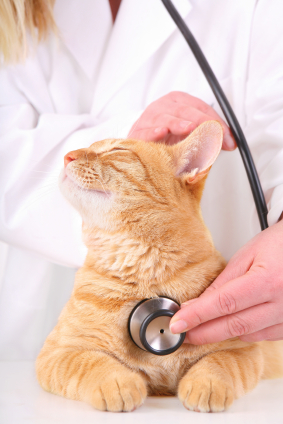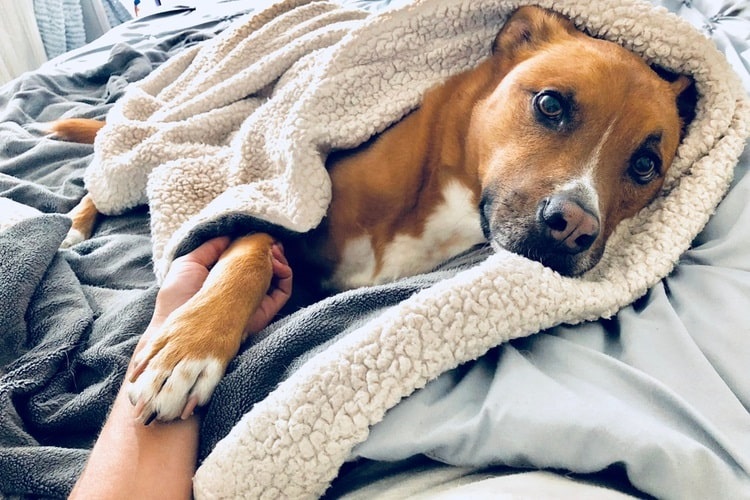Do You Dread Going to the Veterinarian?
Christine Hibbard, CPDT-KA and Anna Baxter, LVT Do you dread trips to the veterinarian with your dog or cat? Do you wonder if the veterinarians and vet techs dread your visit as much as you do? The veterinary staff needs to be able to perform thorough examinations, provide treatments and perform procedures. How can they... [Read More]

Christine Hibbard, CPDT-KA and Anna Baxter, LVT
Do you dread trips to the veterinarian with your dog or cat? Do you wonder if the veterinarians and vet techs dread your visit as much as you do? The veterinary staff needs to be able to perform thorough examinations, provide treatments and perform procedures. How can they be expected to do their best work if they’re fighting your pet every step of the way? It’s stressful for everyone but it’s also unfortunate because it doesn’t have to be this way. With some preparation and training time, you can dramatically lower the stress experienced by your pet, you and the veterinary staff.
Cats
Most dogs love riding in the car but most cats only ride in the car when they’re going one place, the veterinarian. Since safely transporting a cat in the car involves putting them in a carrier, preparing some cats for a trip to the veterinarian can require a bit more preparation.
Love the Cat Carrier
Here are some ideas for teaching your cat to love being in their carrier:
- Start with a hungry cat and a cozy carrier.
- Feeding your cat near his carrier can help him get used to it. Keep feeding your cat near his carrier until he seems relaxed or better yet, he gets curious and inspects the carrier on his own.
- The next step is to feed or give treats just inside the rim of the open carrier and let the cat approach the food voluntarily. We want the cat comfortable going in and out of the crate. Playing games with a ball or fishing pole toy can make going in and out of the crate fun!
- Slowly move the bowl closer and closer to the back of the carrier until he is fully inside. When the cat finishes his meal inside the carrier, give him a few treats at the door of the crate to encourage him to stay inside instead of darting out.
- Gradually increase the time the cat stays in his carrier. Work to Eat toys and stuffed Kongs can be useful, first with the door open a few sessions, then with it closed but with you near by. Gradually increase the time your cat is in the carrier with you in another room or out of the house on a 30-minute errand.
 Love Car Rides
Love Car Rides
You’ve been working hard but in short sessions so now you’re reading to prepare your cat for car rides. Use similar steps with car rides as you used with your carrier work: providing irresistible treats and building on short, happy experiences. First near the car, then near the car with car on, then in the car and then in the car with motor running, etc.
- Move the car down the driveway for a few sessions, then down the street, then down the block gradually increasing the amount of time spent in the car.
- When going places either go home (safe/familiar environment) or to visit the vet (only to get treats or attention) and finally to the vet office for check ups when the pet is relaxed in these situations.
Tolerate Handling
Some cats do not like being handled, not even for petting. If you have a cat who tolerates some petting but will not tolerate having their heads, ears, tail or paws handled, you’ve got work to do:
- Begin with a hungry cat, during a time of day when they’re calm and sleepy. Gently stroke the part of your cat’s body that is most sensitive and pair this touching with treats.
- For example, touch your cat’s ear gently and for just a second. Pair this with a treat. Keep these sessions short, say 30 seconds.
- At each session, increase the duration that you’re touching the body part.
- Once the cat is tolerating a gentle touch for 30 seconds, you can begin increasing the intensity of the manipulation of the body part.
- When your cat will tolerate you handling their ears, paws and tail, begin asking friends and family to stroke your cat gently while feeding treats.
Dogs
Many dog owners are not off the hook when it comes to body handling. Use the same steps described above for getting your dog comfortable being handled. Don’t push; keep the sessions short (before your dog starts pulling away) and positive.
 Leash Reactivity
Leash Reactivity
The problem many dog owners experience during a veterinary visit is their dog barking and lunging at other dogs in the lobby or going in and out of the exam rooms. If your dog barks and lunges at other dogs when on walks, this will only intensify in the confined area of the vet’s office. You can register for one of our Reactive Rover classes to learn how to keep your dog calm on leash around other dogs. In the meantime, if you know your dog is going to go off at other dogs or cats:
- Leave your dog in the car when you arrive at the veterinarian’s office.
- Go inside and sign in with the receptionist, explain your dog’s situation and wait by yourself in the lobby.
- When the vet tech is ready for you, go out to your car and bring your dog inside for his visit.
Veterinarian = Party Time!
Our most important piece of advice for dog and cat owners is to randomly make visits to the vet for positive experiences in between actual appointments. Stop into your vet’s office once a month for a treat party. Stay for a minute or two and give your dog/cat treats and ask the veterinary staff if they’d like to give your pet some treats. This will make arriving and getting through an actual appointment much easier.
The emotional state of your pet during a veterinary exam is extremely important. If your pet is stressed and fearful, anything that happens to them can become forever intolerable. Over time, even the simplest non-confrontational restraint or handling can become difficult, which can resort to more aggressive or even pharmaceutical means of restraint. With some preparation and training, veterinary visits can be a lot less stressful and if we’re doing it right, even fun for your pet!
Are you a Veterinarian or Vet Tech? What advice would you give pet owners about visiting your practice? If you’re a dog or cat owner, what techniques have worked with your pet in making vet visits less stressful?















